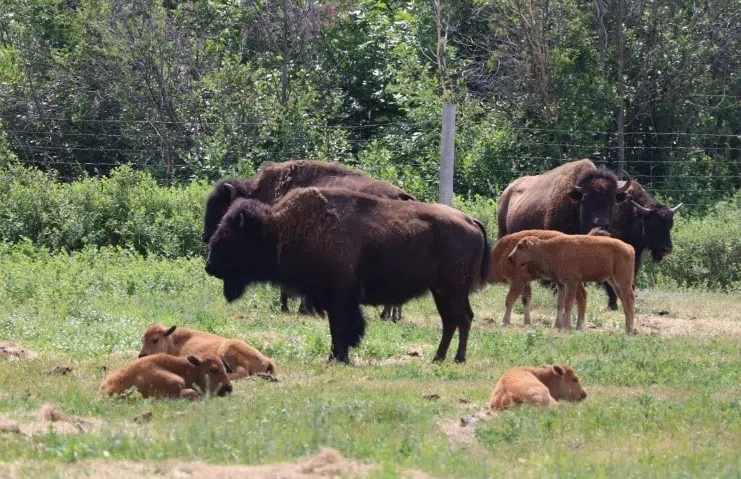New technology is making it easier for visitors to Saskatchewan’s Buffalo Pound Provincial Park to view the park’s bison herd.
According to the Saskatchewan Ministry of Parks, Culture and Sport, 14 of the animals have been fitted with GPS ear tags, allowing staff to track their movements within the park.
Read More:
- Expert on Saskatchewan parks reveals hidden gem camping spots
- New bison calf at Wanuskewin is a Mother’s Day gift like no other
- More warm weather ahead in Saskatchewan, but rain still in short supply
The goal is to enable staff members to track the herd’s movements, monitor the animals’ health and learn more about their grazing patterns and the effectiveness of conservation efforts, while also making it easier for tourists to find a spot to see them up close.
The herd’s location will be tracked by the GPS tags and displayed on a screen in the park’s visitor centre.
“We often receive visitor inquiries about where the bison are in the park,” Dave Bjarnason, the park’s manager, said in a statement.
“The herd lives on 250 acres of rolling hills and is not always visible from the fence line. The display helps visitors determine if they can find a spot to see them up close, and it gives us another opportunity to educate people about the bison.”
Alana Ross, Saskatchewan’s minister for parks, culture and sport, said the herd is a part of the region’s history and a “crucial” part of the park’s ecosystem.

The ministry said livestock producers in the province could also benefit from the data gathered through the new tracking technology (Saskatchewan Ministry of Parks, Culture and Sport/Submitted)
Bison were introduced back to the park in 1972, the ministry explained, and the size of the herd has fluctuated over the years since then.
“With this new tracking system, park staff can make sure both the bison and the land remain healthy,” Ross said in a statement. “It will also help visitors create a deeper connection to nature and the cultural importance of these remarkable animals.”
The ministry said livestock producers in the province could also benefit from the data gathered through the new tracking technology, as the information collected “will lay the groundwork for future projects about bison grazing behaviour and using technology to track livestock.”
Patrick Clark, resource maintenance supervisor at the park, said the tracking project, which began last fall, is already producing valuable insights.
“It’s for help with research, so we can see what their grazing patterns are throughout the pasture out here, and then also so we can track their locations for visitors as well,” said Clark.
Each fall, park staff bring in the entire herd to check on their health, provide any necessary treatments and install the GPS tags.
“About mid October we bring all our bison in and we run them through the chutes just to get a good look at them for health and if they need medicine or treatment for anything, and check their condition,” said Clark.
Unlike regular ear tags, these high-tech devices include solar panels to keep them charged.
“They have little solar panels on the backside of them too, so that they can charge in the sunlight,” Clark said.
Despite Saskatchewan’s harsh winters, the technology has proven reliable, Clark added.
“There have been some that have fallen out, so we will have to replace a few of them coming this October. But other than that, they seem to be holding up pretty good, even with the extreme cold temperatures out here,” he said.
The GPS tracking also helps staff learn how the herd uses the park’s landscape.
“It’s pretty surprising how much ground one animal can make. In a matter of seven days, they’ll cover the entire pasture from end to end,” Clark said.
The data is also helpful for pasture management and maintaining the park’s prairie habitat.
“If there’s anything that we can do on our side to move them to different locations so they can focus in other areas, while we can let those areas that maybe they’re overgrazing a little bit to re-establish a little, that kind of thing,” explained Clark.
“It’s a little bit more for pasture management.”
Buffalo Pound Provincial Park is located northeast of Moose Jaw.
–with files from 980 CJME’s Jacob Bamhour











